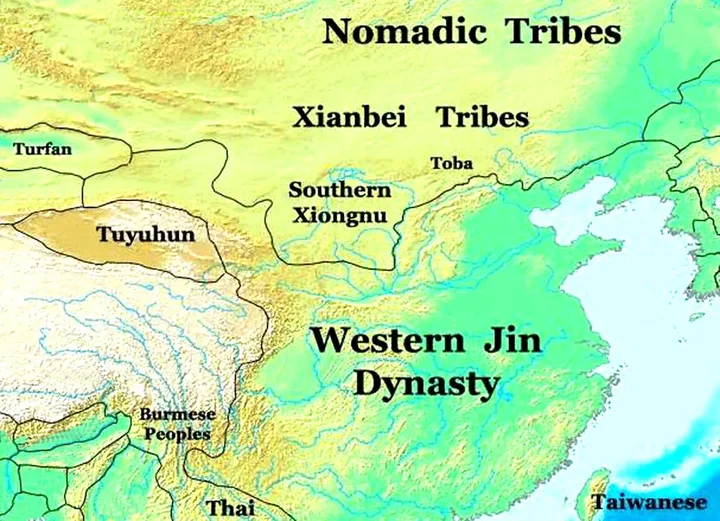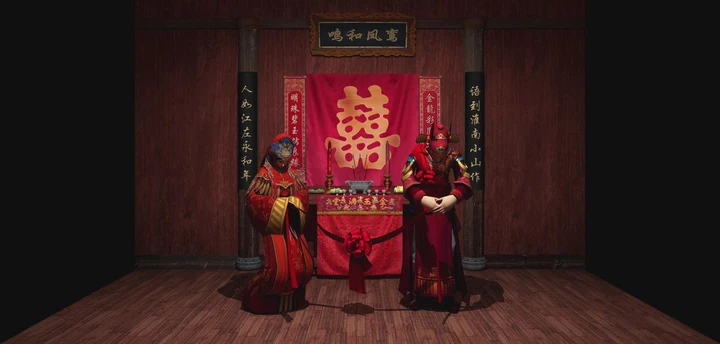Chinese Dynasty Replacement Romance (P2)
With the failure of Wang Mang's vigorous restructuring, the new dynasty also came to an end. At the end of the new dynasty, the Lvlin Chimei Uprising broke out, and Liu Xiu, the clan of the Han Dynasty, took advantage of the situation and proclaimed himself emperor, continuing the national title of "Han".

8. Eastern Han Dynasty (25 AD - 220 AD, 195years)
In 25 AD, Liu Xiu proclaimed himself emperor and established the Eastern Han Dynasty, making Luoyang the capital.After the unification of the world, the army will be stopped and the people will be raised, which is called "Guangwu Zhongxing" in history. After the emperor of Han He succeeded to the throne, he broke through the northern Xiongnu, recovered the Western Regions, and created the "Long of Yongyuan", and the national strength of the Eastern Han Dynasty reached its peak. In 184 AD, the Yellow Turban Uprising broke out. Although it suppressed the civil unrest, it led to the local support of troops and self-respect. After the Dong Zhuo Rebellion, the Eastern Han Dynasty survived in name only. In 220 AD, Cao Pi usurped the Han Dynasty and the Eastern Han Dynasty fell.

9-1. Three Kingdoms period - Cao Wei (220 AD- 265 AD, 45 years)
The Three Kingdoms is a historical period of division from the Eastern Han Dynasty to the Western Jin Dynasty. During the Battle of Chibi, the prototype of the Three Kingdoms was established. In the 220th year AD, Cao Pi usurped the Han Dynasty and proclaimed himself the emperor, set the capital in Luoyang, the country name "Wei", known as Cao Wei in history, and the history of the Three Kingdoms officially began.

9-2. Three Kingdoms period - Shu Han (221 AD- 263 AD, 43 years)
In 221 AD, Liu Bei proclaimed himself emperor and rebuilt the Han Dynasty, making Chengdu the capital and the country name "Han". Historically known as Shu Han. Zhuge Liang and Jiang Wei of Shu Han led the army to expedition Cao Wei in the north many times, but they still failed to change the pattern of three-legged confrontation. In the first year of Yanxing (263), Liu Shan surrendered to Cao Wei and Deng Ai and enjoyed the country for 43 years.

9-3. Three Kingdoms period - Dong Wu (222 AD- 280 AD, 58 years)
In 229 AD, Sun Quan proclaimed the emperor, established the capital of Ye, and the country was called "Wu", which was called Soochow in history, and the Three Kingdoms were officially established. The Eastern Han Dynasty had a population of 50 million, but only 8 million remained in the Three Kingdoms. Six-sevenths of the 50 million people died. Plagues, natural disasters, and wars are the true portrayal of the Three Kingdoms. In 280, Jin destroyed Soochow Wu, unified China, and the Three Kingdoms period came to an end.

10-1. Jin Dynasty (266 AD - 420 AD, 154 years)
Western Jin Dynasty (266 AD - 316 AD, 51 years)
The Jin Dynasty inherited the Three Kingdoms, and descended from the Southern and Northern Dynasties, belonging to one of the Six Dynasties. In the 156th year of the Jin Dynasty, the seventh generation of the calendar was passed down to the sixteenth emperor. On February 4, 266 AD, Sima Yan usurped the Wei Dynasty, established the state as Jin, and made Luoyang the capital, which was called the Western Jin in history. During the Taikang period (280-289), there was a flourishing scene, which was called "the rule of Taikang" in history. In 280 AD, the Eastern Wu Dynasty was destroyed and the unification was completed.

10-2. Jin Dynasty (266 AD - 420 AD, 154 years)
Eastern Jin Dynasty (317 BC- 420 BC, 103 years)
In order to consolidate the imperial power, Emperor Wu of Jin used the enfeoffment system of the Western Zhou Dynasty. The appointed princes and ministers formed a huge class of aristocratic landlords in the Western Jin Dynasty. the kings led their troops and horses to occupy each side. After the death of Emperor Wu of Jin, the kings fought for the central power, and the internal strife continued. The civil war lasted for 16 years (291-306), which is called the Eight Kings Rebellion in history. Emperor Min of Jin moved the capital to Chang'an. In 316 AD, Chang'an was conquered. Sima Ye, the last emperor of the Western Jin Dynasty, surrendered to the Xiongnu. The Western Jin Dynasty fell. From then on, the north entered the period of the Five Hus and Sixteen Kingdoms. In 317 AD, when the Jin family crossed to the south, Sima Rui established the Eastern Jin Dynasty in Jianye, and the Eastern Jin Dynasty had several expeditions to the north. In 383 AD, the Eastern Jin and the Former Qin were temporarily consolidated after the Battle of Feishui. In 420 AD, Liu Yu established the Song Dynasty, the Eastern Jin Dynasty fell, and China entered the period of the Northern and Southern Dynasties.

11. Five Hus and Sixteen Kingdoms (304 AD - 439 AD, 135 years)
"Five Hus and Sixteen Kingdoms" refers to the regimes established in northern China from the end of the Western Jin Dynasty to the Northern Wei Dynasty's unification of the north. The sixteen regimes established by the five Hu people, Jie, Qiang and Di, were the main ones, so they were called "Five Hus and Sixteen Kingdoms", or "Sixteen Kingdoms" for short. But in fact, there were not only five ethnic minorities invaded, and the number of regimes was far from sixteen. This period started from the establishment of Han Zhao (later known as Qian Zhao) and Chenghan respectively in 304 AD by Liu Yuan and Li Xiong, and ended in 439 AD when Tuoba Tao of the Northern Wei Dynasty destroyed Northern Liang. The scope roughly covers North China, Shu, Liaodong, and the farthest reaches to Mobei and Western Regions. The Northern Wei Empire unified North China, and in 135 AD, the era of Wuhu Chaohua came to an end. Tuoba Tao, Emperor Taiwu of the Northern Wei Dynasty, and Liu Yilong, Emperor Wen of the Song Dynasty of the Southern Dynasty, confronted the north and the south, and officially entered the era of the Northern and Southern Dynasties.

12. The Southern and Northern Dynasties (420 AD - 589 AD, 170 years)
The Southern and Northern Dynasties are the collective name of the Southern and Northern Dynasties. The Northern and Southern Dynasties period was a period of great division in Chinese history and also a period of great ethnic integration in Chinese history. It started from the establishment of Liu Song by Liu Yu in the Eastern Jin Dynasty in 420 AD, and ended in 589 AD when the Sui Dynasty eliminated Chen. There were four dynasties in the Southern Dynasty (420-589): Song, Qi, Liang, and Chen. The Northern Dynasty (439-581) had five dynasties: Northern Wei, Eastern Wei, Western Wei, Northern Qi and Northern Zhou. This is the most frequent period of regime change in Chinese history. Due to the long-term feudal domination and continuous wars, the development of Chinese culture in this period was particularly affected. Its outstanding performance is the rise of metaphysics, the import of Buddhism, the flourishing of Taoism, and the introduction of Persian and Greek cultures.

13. Sui Dynasty (581 AD - 618 AD, 38 years)
The Sui Dynasty was a unified dynasty re-established in the north by the Han nationality in Chinese history, ending the three-hundred-year division of the Wei, Jin, Southern and Northern Dynasties. Completed the second great unification in Chinese history. Because the culture, system and social characteristics of the Tang Dynasty and the Sui Dynasty are in the same line, historians often refer to the two dynasties together as the Sui and Tang Dynasties. Yang Jian's country name was "Sui" and his capital was Daxing City (now Xi'an). In order to consolidate its rule, the Sui Dynasty carried out drastic reforms in the fields of politics, economy, culture and diplomacy. Politically, the system of three provinces and six ministries was established to consolidate the centralization of power. The official implementation of the imperial examination system, the selection of outstanding talents, and the weakening of the monopoly of the aristocratic family on officials have far-reaching influence on later generations. The method of selecting talents by examination is still used in China and many countries around the world. Although the Sui Dynasty only survived for more than 30 years, like the Qin Dynasty for more than ten years, it was very "short-lived", but it was precisely these two "short-lived" dynasties that completed two major unifications in Chinese history.

14. Tang Dynasty (618 AD - 907 AD, 289 years)
The Tang Dynasty is the most brilliant and splendid dynasties in Chinese feudal history, with the longest unification time, and is recognized as one of the most powerful dynasties in China. In the 14th century of the Tang Dynasty, there were 21 emperors, who enjoyed the country for 289 years. After Emperor Gong of Sui and Yang You "chanted" the throne, Li Yuan took "Tang" as his country and called himself emperor, and still set his capital in Chang'an. The Tang Dynasty was the largest and only unified Central Plains Dynasty that did not build the Great Wall. The Tang Dynasty and the Arab Empire were the most powerful empires in the world at that time, and their reputations spread far and wide overseas, and they had contacts with Asian and European countries. After the Tang Dynasty, overseas Chinese were often referred to as "Tangren", and the place where the Chinese lived was called "Chinatown". Japanese scholar Hino Kaizaburo even believes that the population of the Tang Dynasty peaked at 20 million households, with a population of 140 million.





